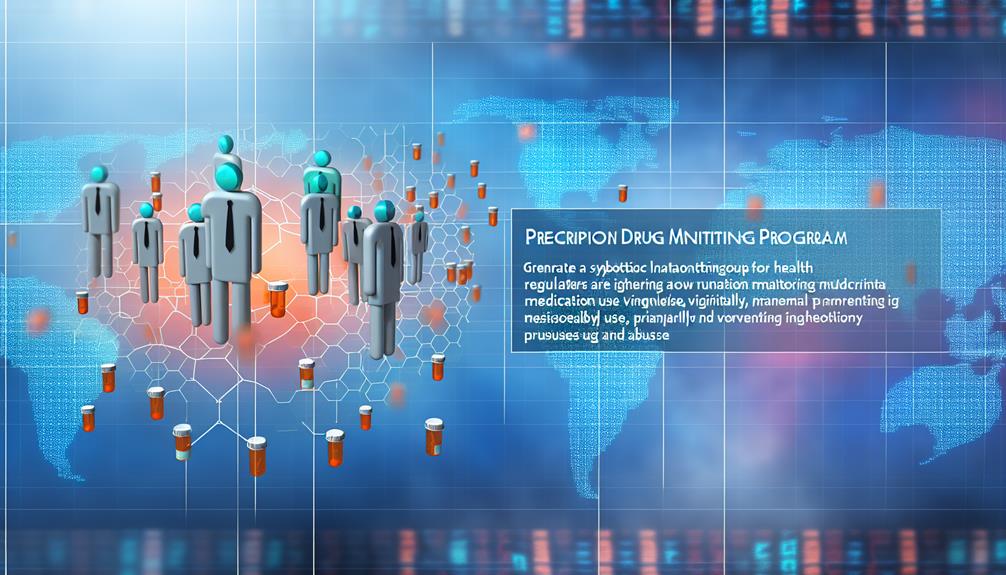Did you know that prescription drug abuse is a growing concern, with approximately 18 million Americans misusing prescription medications each year? In light of this alarming statistic, it becomes crucial to examine the role of regulators in prescription drug monitoring programs.
These programs aim to track the prescribing and dispensing of controlled substances, providing valuable data to identify and prevent abuse. But what exactly is the role of regulatory agencies in these monitoring programs? How do they collaborate with healthcare professionals, pharmacies, and law enforcement agencies? And what challenges do they face in their efforts to combat prescription drug abuse?
Let's explore the significance of regulators in prescription drug monitoring and delve into the impact they have on preventing misuse and ensuring patient safety.
Importance of Regulators in Prescription Drug Monitoring

Regulators play a crucial role in prescription drug monitoring, ensuring the effective and efficient oversight of controlled substances. Regulatory oversight involves the monitoring and enforcement of laws and regulations related to the prescribing, dispensing, and use of prescription drugs. Through their oversight activities, regulators aim to prevent drug abuse, diversion, and other illicit activities associated with controlled substances.
One of the key tools regulators use in prescription drug monitoring is data analytics. By analyzing data from various sources, including prescription drug monitoring programs (PDMPs), regulators can identify patterns and trends that could indicate potential misuse or abuse of prescription drugs. This allows them to take proactive measures to address any issues and ensure the safety and well-being of patients.
Data analytics also helps regulators in identifying healthcare providers who may be overprescribing or engaging in fraudulent activities. By analyzing prescribing patterns and comparing them with established guidelines and norms, regulators can identify outliers and take appropriate action to address any potential risks to public health.
Role of Regulatory Agencies in Monitoring Programs
The role of regulatory agencies in monitoring programs is crucial for ensuring effective oversight of prescription drug use and preventing illicit activities. These agencies play a vital role in implementing and enforcing regulations related to prescription drug monitoring programs (PDMPs).
Their responsibilities include developing policies and guidelines, overseeing the implementation and operation of PDMPs, monitoring compliance, and taking enforcement actions when necessary.
Regulatory agencies are responsible for setting the standards and guidelines that govern the operation of PDMPs. They establish the rules and requirements that pharmacies, healthcare providers, and other stakeholders must adhere to when participating in these programs. By doing so, they ensure that the monitoring programs are effective in tracking the prescribing, dispensing, and use of prescription drugs.
In addition, regulatory agencies monitor the compliance of pharmacies and healthcare providers with PDMP requirements. They conduct regular audits and inspections to ensure that these entities are properly reporting prescription drug data and following the necessary protocols. By monitoring compliance, regulatory agencies can identify any issues or gaps in the monitoring programs and take corrective actions to address them.
Furthermore, regulatory agencies play a crucial role in enforcing the regulations and laws related to prescription drug monitoring. They've the authority to investigate complaints, issue penalties or fines for non-compliance, and revoke licenses or certifications if necessary. These enforcement actions serve as deterrents and ensure that the monitoring programs are being taken seriously by all stakeholders.
Collaborative Efforts to Enhance Drug Monitoring Systems

To enhance drug monitoring systems, stakeholders across the healthcare industry are collaborating to implement innovative strategies and technologies.
One key aspect of these collaborative efforts is the focus on data sharing. By sharing relevant information across different healthcare entities, such as pharmacies, healthcare providers, and regulatory agencies, it becomes easier to identify patterns of prescription drug misuse and abuse. This data sharing can enable healthcare professionals to make more informed decisions when prescribing medications, as well as help identify patients who may be at risk for addiction or overdose.
Technology integration is another crucial component of enhancing drug monitoring systems. By leveraging advanced technologies, such as electronic health records (EHRs) and prescription drug monitoring program (PDMP) databases, healthcare providers can access real-time information about a patient's prescription history, including any controlled substances they've been prescribed. This integration of technology allows for more accurate and efficient monitoring of prescription drug use, enabling healthcare professionals to identify potential issues and intervene when necessary.
Furthermore, collaborative efforts are also focused on improving interoperability between different healthcare systems. This ensures that data can be seamlessly shared and accessed across different platforms, facilitating more comprehensive monitoring and analysis of prescription drug use.
Regulators' Impact on Prescription Drug Abuse Prevention
Collaborative efforts with regulators have significantly impacted the prevention of prescription drug abuse. By implementing regulatory measures and conducting effectiveness evaluations, regulators play a crucial role in curbing the misuse and abuse of prescription drugs.
Regulatory measures include the implementation of prescription drug monitoring programs (PDMPs), which are state-run databases that track the prescribing and dispensing of controlled substances. These programs allow regulators to identify potential cases of abuse, monitor prescribing patterns, and intervene before addiction takes hold. Additionally, regulators work closely with healthcare providers and pharmacies to ensure compliance with prescribing guidelines and to prevent the diversion of prescription drugs into the illicit market.
The effectiveness of these regulatory measures is evaluated through ongoing monitoring and analysis of data collected from PDMPs. These evaluations help regulators identify trends, assess the impact of interventions, and make informed decisions about policy changes or enforcement actions. By continuously evaluating the effectiveness of their efforts, regulators can refine their strategies and target resources where they're most needed.
Challenges and Future of Regulators in Monitoring Programs

Regulators face numerous challenges and must navigate the evolving landscape to effectively monitor prescription drug abuse prevention programs and shape their future.
One of the key challenges they encounter is the rapid advancement of technology. As monitoring programs become more sophisticated, regulators must keep up with the latest innovations to ensure accurate and efficient data collection and analysis. This requires continuous training and education to stay abreast of emerging technologies and their implications for monitoring programs.
Another challenge regulators face is the need for collaboration and coordination among different stakeholders. Prescription drug abuse prevention programs involve multiple agencies, healthcare providers, and law enforcement entities. Regulators must facilitate effective communication and cooperation among these diverse groups to ensure the success of monitoring programs. This includes establishing clear guidelines and protocols for data sharing and information exchange.
Looking ahead, the future of regulators in monitoring programs is promising yet complex. With the ongoing opioid crisis and the emergence of new substances of abuse, the role of regulators will continue to evolve. They'll need to adapt to changing trends and develop strategies to address emerging challenges. This may involve implementing new technologies, such as machine learning and artificial intelligence, to enhance data analysis and identify patterns of abuse.
Additionally, regulators must stay informed about new legislation and regulations that impact prescription drug monitoring programs, and advocate for policies that support effective prevention and intervention efforts.








